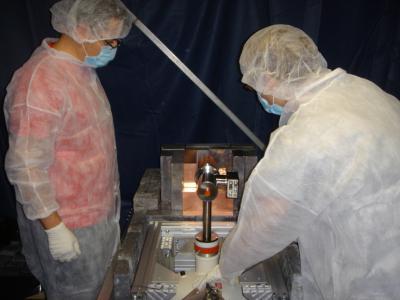But Hubble showed us distant supernovae in the 1990s and researchers realized the universe had actually been expanding slower in the past, not faster - and that was a pickle for current theory. So researchers hypothesized Einstein's theory of gravity and a cosmological constant might account for it, or some strange kind of energy-fluid filled space or Einstein's theory of gravity was wrong and a new one including some kind of field creates cosmic acceleration. No one knew what it was, but they called this mystery Dark Energy.
Dark energy often goes hand-in-hand with dark matter - something exerts gravitational influence over galaxies - but telescopes can't see dark matter either.
A group of researchers now say they have detected a seasonal signal variation similar to what they might find if dark matter turned out to be what physicists call Weakly Interacting Massive Particles (WIMPs) - and they did it in a Minnesota mine, not outer space.
Theorists have predicted that dark matter experiments would detect an annual modulation because of the relative motion of the Earth and sun with respect to the plane of the Milky Way galaxy.
The sun moves in the plane of the galaxy on the outskirts of one of its spiral arms at a speed of 220 kilometers per second (136 miles per second). The Earth orbits the sun at 15 kilometers per second (18.5 miles per second). During winter, Earth moves in roughly the opposite direction of the sun's movement through the galaxy, but during summer, their motion becomes nearly aligned in the same direction. This alignment increases Earth's net velocity through a galactic halo of dark matter particles, whose existence scientists have inferred from numerous astronomical observations.
WIMPs would be moving in random directions in this halo, at velocities similar to the sun's. You find yourself in a situation similar to a car moving through a cloud of gnats - the faster the car goes, the more gnats will hit the front windshield.
The Coherent Germanium Neutrino Technology (CoGeNT) experiment seems to have detected an average of one WIMP particle interaction per day throughout its 15 months of operation, with a seasonal variation of approximately 16 percent. Energy measurements are consistent with a WIMP mass of approximately 6 to 10 times the mass of a proton.
"We cannot call this a WIMP signal. It's just what you might expect from it," said Juan Collar, associate professor in physics at the University of Chicago.

University of Chicago physicist Juan Collar (left) and University of Washington graduate student Mike Marino inspect the CoGeNT experiment at the Soudan Mine in Minnesota. CoGeNT has detected a seasonal signal variation during its first year of operation. This is what scientists would expect if dark matter is made of Weakly Interacting Massive Particles (WIMPs), but the CoGeNT collaboration considers the results to be inconclusive. Credit: CoGeNT Collaboration
These results could be consistent with those of the Italian DArk MAtter (DAMA) experiment, which has detected a seasonal modulation for years. "We are in the very unfortunate situation where you cannot tell if we are barely excluding DAMA or barely in agreement. We have to clarify that," Collar said.
In particle physics, he further cautioned, agreement between two or three experiments doesn't necessarily mean much. The pentaquark is a case in point. Early this century, approximately 10 experiments found hints of evidence for the pentaquark, a particle consisting of five quarks, when no other known particle had more than three. But as time went on, new experiments were unable to see it.
Collar and his colleagues have calculated the probability that their finding is a fluke to be five-tenths of a percent, or 2.8 sigma in particle physics parlance, a field that accepts 5-sigma. So their results to-date are about as accurate as a political Gallup poll.
"It's not an exact science yet, unfortunately," Collar said. "But with the information we have, the usual set of assumptions that we make about the halo and these particles, their behavior in this halo, things seem to be what you would expect."
Other dark-matter experiments, including Xenon100, have not detected the seasonal signal that CoGeNT and DAMA have reported.
"If you really wanted to see an effect, you could argue that the Xenon100 people don't have the sensitivity to Juan's result," said Rosner, who is not a member of the CoGeNT collaboration. "On the other hand, they've done a number of studies of what their sensitivity is at low energies and they believe they're excluding this result."
CoGeNT operated from December 2009 until interrupted by a fire in the Soudan mine in March 2011. Fifteen months of data collection is a relatively brief period for a dark-matter experiment. The fire did not directly affect the experiment, but the CoGeNT team has not been able to examine the detector because of clean-up efforts. The detector may no longer work, or if it does work, it may now have different properties.
"This effect that we're seeing is touch-and-go. It's something where you have to keep the detector exquisitely stable," Collar said. If a single key characteristic of the detector has changed, such as its electronic noise, "We may be unable to look for this modulation with it from now on."
The putative mass of the WIMP particles that CoGeNT possibly has detected ranges from six to 10 billion electron volts, or approximately seven times the mass of a proton. "To look for WIMPs 10 times heavier is hard enough. If they're this light, it becomes a nightmare," Collar said.
Papers:
J.I. Collar, 'A Realistic Assessment of the Sensitivity of XENON10 and XENON100 to Light-Mass WIMPs', arXiv:1106.0653v1
C.E. Aalseth, P.S. Barbeau, J. Colaresi, J.I. Collar, J. Diaz Leon, J.E. Fast, N. Fields, T.W. Hossbach, M.E. Keillor, J.D. Kephart, A. Knecht, M.G. Marino, H.S. Miley, M.L. Miller, J.L. Orrell, D.C. Radford, J.F. Wilkerson, K.M. Yocum, 'Search for an Annual Modulation in a P-type Point Contact Germanium Dark Matter Detector', arXiv:1106.0650v1






Comments